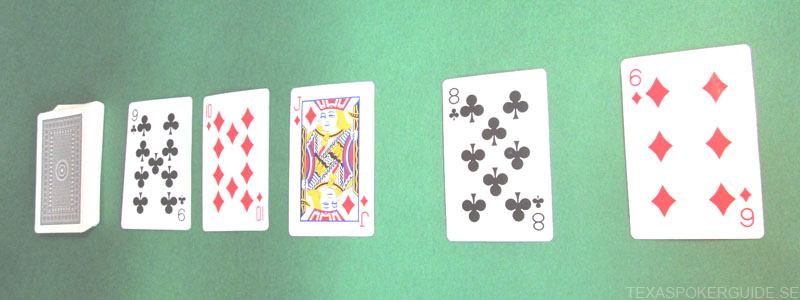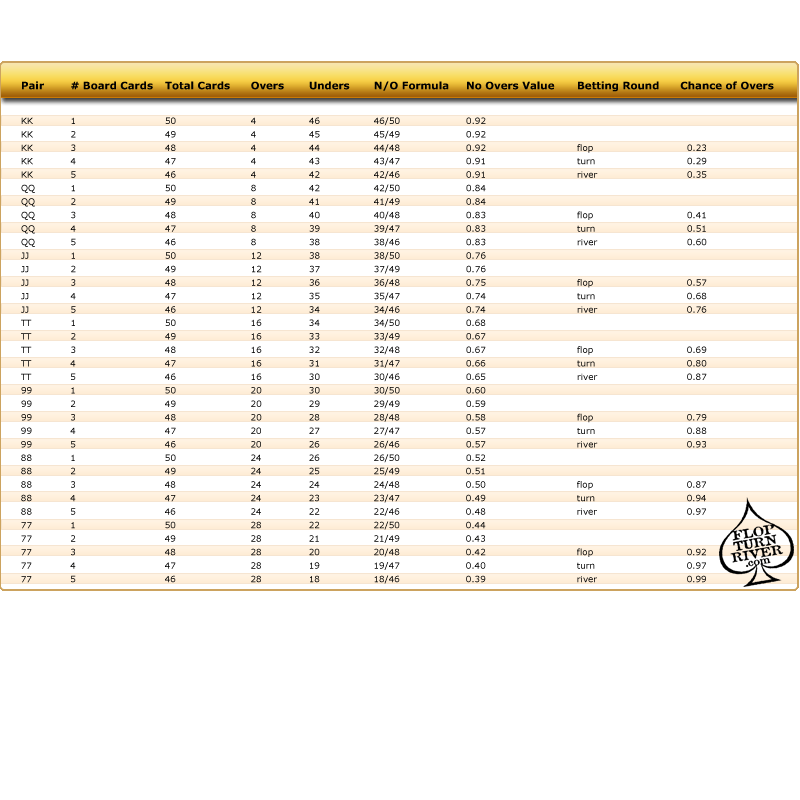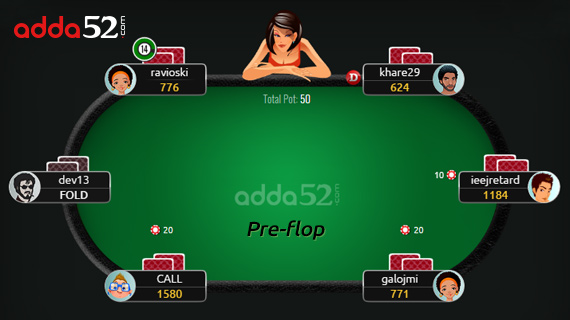Texas Holdem River Turn Flop
- Texas Holdem River Turn Flop Lights
- Texas Holdem River Turn Flop Game
- Texas Holdem River Turn Flop Key
- Texas Holdem River Turn Flop 2
- Texas Holdem Flop River Turn
Texas Hold’em Strategy Flop, Turn, and River Strategy. Playing the Flop. As mentioned before, the flop is a defining point in a poker hand. On the flop you get to see 71 percent of your hand for the cost of one round of betting. On the Flop, Turn, and River, the last player to act is always the Button. Accordingly, on a 6-handed table, the post-flop order of play would be the SB starts followed by the BB, UTG, HJ, CO, and BTN. Are There Any Exceptions? The post-flop order never changes.
In the post Flop texture I discussed one view of flop texture, which is to divide flops into dry boards or wet boards, dependent on the composition of the three cards. In this post, I shall discuss another approach, which concentrates on suitedness and connectedness. In this post, I will be referring to the groups in Hand Rankings and Strengths.
It is almost a truism to say that previously strong pre-flop pocket cards can turn into a mediocre or trash combination dependent on the flop, and previously mediocre or possibly trash pocket cards can be transformed into strong or even monster hands dependent on the flop. Since we are considering playing online poker, and hands move at a fast clip, we need a way to quickly evaluate the flop, to determine whether or not to fold, or to continue to bet on the turn, the river, and eventually to participate in the showdown.
Firstly, we ask how many cards of the same suit does the board have. Is a flush draw possible? There is a better chance if all three cards are of the same suit; if you have two cards of a matching suit you have a made flush, if you have one card of a matching suit, you need only match on the turn or the river to turn the hand into a made flush. If there are two cards of the same suit, and you have one or two cards of a matching suit, then help from the turn or river is required, but it’s possible to turn your hand into a made flush.
Next, we ask how many connected cards does the board have. If the three cards are all connected there is a good chance of a straight draw, and you might even have a made straight draw with your own pocket cards. If two cards are connected and there is a one-gap or two-gap in the other card, you may need only one matching card, and assistance from the turn or the river to make a made straight draw.
Finally, we ask how many face cards does the board have, and how many pairs, preferably high pairs there are. If you are playing a disciplined game, and restricting your pocket cards to Groups 1 to 3 in early position, and Groups 4 and 5 in late position, face cards in the flop are more attractive because most players will play through to the flop holding face cards, in the hopes of making a two pair, a trip, a full house, or even four of a kind.
Rainbow flops
By way of definition, a rainbow flop is a flop where all cards are of a different suit, so no flush draws are possible. If you have two suited matching cards, then a backdoor flush draw, with help from the turn and the river have a very low probability of occurring.
Most rainbow flops are where there is one high card, or where the flop is all rags, which are cards with a denomination of 8 and under. An example of a rainbow flop with one high card is:

With this flop, the best pocket cards are K9s (a Group 6 hand, so really only playable through to the flop in late position) making a two pair, or any King with a high kicker for a top pair.
Another rainbow flop, which is all rags, is:
Here, pretty much any two pair hand would be advantageous, but a Group 4 hand 88 would make a trip, and it’s unlikely one would bet a Group 7 hand 44 or 22 through to the flop to make the lower trips.
2-suited flops
A 2-suited flop contains two cards of the same suit. For example:
A flush draw, which means you if have a Group 2 A ♢ J ♢ or Group 4 T ♢ 9 ♢, you have a good chance to make a flush draw on the turn or the river, and should bet through to the showdown. A single high-value matching card, such as A ♢, or K ♢, might lead to a back door flush draw, but would need a matching ? ♢ on both turn and river, which is a low probability outcome.
3-suited flops
A 3-suited flop is where all the cards are of the same suit. For example:

Texas Holdem River Turn Flop Lights
If you have two matching pocket cards, such as Group 3 Q ♢ J ♢ or A ♢ 10 ♢, you effectively have the nut flush and should play aggressively all the way to the showdown, because you are hardly likely to be beaten. However, you need to beware Group 6 K9s or K9 because a K or 9 on the turn and the river will make a full house. This is an unlikely, but possible, outcome and needs to be accounted for.
2-connected flops
This type of flop makes it possible to make a straight draw, and because players prefer to play connected pocket pairs, and a two pair is also more likely. For example:

This is a rainbow flop and an open-ended straight draw is possible, with a one in three chance of a straight. So a Group 4 KQ requires an A or 9 to make a straight on the turn or the river, and a Group 4 98s requires a Q or a 7 on the turn or river to make a straight draw.
3-connected flops
Texas Holdem River Turn Flop Game
A 3-connected flop makes it possible for a player to have a made straight. For example:
Here, a Group 2 KQs or a Group 4 KQ are required to have a made straight, but note also, a Group 5 87s or Group 8 87. The danger of playing the lower end pocket cards is you might be outplayed by the high-end pocket cards. It’s also possible to play Group 1 QQ or Group 4 88 and rely on the turn or river cards to make a straight.
High pair flops
A dangerous flop is a high pair flop. Most players will bet through to the flop on high pocket cards. For example:
A Group 1 JJs will result in four of a kind, a Group 3 KJs will result in a full house, a Group 2 KQs or Group 4 KQ will result in a two pair. The danger with playing a high pair is other players, playing through to the flop with their high pocket cards, may outplay you despite holding strong pocket cards yourself. Dangerous territory, indeed.
Low pair flops
The danger for a playing encountering a low pair flop is from other loose aggressive or loose passive players. For example:

it is likely that a tight aggressive player will fold any hand containing a 4. But loose players might likely play a hand containing a 4 for a trip, or a 9 for a two pair. However, any top pair is a viable combination for a two pair or full house, with assistance from the turn or the river.
High cards only
Where there are high cards only, such as:
invites participation from a player playing Group 1 to Group 3 hands. Caution must be exercised because other players playing to the flop may have similarly strong hands, so it is necessary to observe other players’ betting patterns to determine whether to continue. So a Group 3 QJs or Group 5 QJ will be a straight, a Group 1 AA or KK, Group 2 TT will be a trip. Other winning combinations will be possible with assistance from the turn or river, but that’s another story.
In this post, I have covered another approach to evaluating the flop, by breaking it down into suitedness and connectedness, with other considerations, such as the rainbow flop and flops with pairs, along the way.
When I first started playing poker, I was solely an online player. In fact, it was about two years before I even thought about playing in a live game. Then, I discovered a local “Pub Poker” tournament and decided to give it a try. In my initial outing, I had no clue what it meant to “burn” a card or that it even existed. It took some rather “tough love” from my playing partners to figure out how it worked.
Eventually, I discovered that burning cards are an important part of Texas Hold’em and variant of poker that involves play over multiple streets. In fact, there is more than one reason cards are burned and each is an integral part of the game. This article will explain everything that I have learned about the subject so far.
There are up to 3 total burn cards in a Texas Hold’em poker hand. Before dealing the flop, turn, or river, the dealer is required to take the top card from the deck and burn (discard) it. The burn card is never to be shown to the players, as it could influence future decision-making. This practice is required in all multi-street games, not just Hold’em, whether at a casino or a casual home game. The purpose of the burn card is to prevent cheaters from gaining an advantage with marked cards.
Do You Burn a Card Before Dealing to the Players?
No. Once the deck is cut, the dealer deals the first card directly off the top of the deck. The only time a card is burned is immediately before dealing the flop, turn, or river. No more than 3 cards should ever be burned during a hand of poker.
What Is the Exact Sequence the Cards Are Dealt?
The playing of a poker hand generally adheres to the following 6 step ritual. The following routine is the same no matter where or who you play with. Stick to this sequence and you can be sure you are burning the correct cards at the right times.
- The Shuffle Before playing, the cards are generally shuffled at least 4 times.
- The Cut In most games, the player to the dealer’s right is given the option of cutting the cards.This is where the deck is split into two halves with the bottom half being placed over and on top of the top half. In casinos, the dealer almost always does the cut. You are not generally allowed to ask to cut the cards since the casino wants the players only to be able to touch the cards dealt to them.
- The Deal The dealer then begins dealing to the Small Blind and continues around the table in a clockwise fashion until everyone has the required number of cards (2 for Texas hold’em).
- The Flop After the pre-flop betting round concludes, the dealer then burns 1 card and places it face down on the table in front of him, near where the deck of cards rests. He then deals the next 3 cards face up on the table, called the “flop”.
- The Turn Once the action is closed on the flop, the dealer then burns another card and places the next card (just 1) face up on the table, called the “turn”.
- The River After the action closes on the turn, the dealer burns the final cards and places the next card in the deck on the table, called the “turn”. This is the third and final burn card.
Where Do I Put the Burn Cards While Dealing?
Generally, you can put them anywhere you want, just not back in the deck. Sometimes, I see dealers set them in the muck. My advice is to have a nice neat pile next to the spot you keep the deck. That way, as you deal, everyone at the table can be sure that you have burned the cards like you are supposed to. This simple way of storing the cards will end a lot of disputes over the burn cards. Even so, everyone occasionally makes a mistake and forgets to deal to a particular person or even has a burn card oversight.
Texas Holdem River Turn Flop Key
What If I Forget to Burn a Card?
It depends on when someone notices the card wasn’t burned. If the betting for the round has already been completed, then the actions stand and you continue on as normal. If someone notices before a bet is made, then the card that was supposed to be the burn is set aside as a new card is dealt.
If there is any dispute as to whether a card was burned or not, the casino floor is typically called over for a decision. In home games, there is no hard and fast rule for dealing with this type of dispute. Hopefully, your buddies are friendly enough to just come to a mutually agreed upon decision, so you can move on.
Texas Holdem River Turn Flop 2
If you are looking for a simple way to resolve the issue, here is something I’ve seen done in the past. Basically, you just put the incorrectly dealt card back into the remaining undealt cards and reshuffle the deck. Then, continue as normal and burn and turn the next street. This ends all conversation about whether someone was cheating or not by not burning a card.
Other Benefits of the Burn Cards
Texas Holdem Flop River Turn
While burn cards were originally intended to counter card marking, there are two additional secondary uses.
- Preventing Second Dealing The first is another anti-cheating purpose to prevent something known as second dealing. This is when a player knows the top and then chooses to deal the second card instead, hoping for a better outcome than the first card would have given. A good example of this is when either the dealer or another player has a flush or straight draw. Second dealing effectively gives that player two changes at making their hand, unfairly increasing their odds of winning.
- Correcting Irregularities I really like this rule, as it speeds up the game. An example of an irregularity is when a card is accidentally flashed or turned over during dealing. In this case, the dealer is to pull the offending card aside to be used as the burn card for the flop. The player who was supposed to get the misdealt card then receives a replacement once all of the other cards have been distributed. An exception to the rule is when the card is flashed or turned over while being given to players in the blinds. In this case, a misdeal is announced, and the cards have to be reshuffled to start again.
Do Burn Cards Affect Probabilities?
No. Probabilities are determined by figuring out the math based on known cards and unknown cards. It doesn’t matter where the unknown cards are, whether in the muck, in the burn pile, or in another player’s hand. Unknown is unknown. The only way that the probabilities can be affected by the burn card is that it is seen by someone, either deliberately or accidentally.
If the Discarded Cards Are Named Burn Cards, What Are the Flop Turn and River Called?
Community, or common, cards. These cards are shared by everyone else at the table and used to make the best 5 card hand. The two cards that you hold in your hand are called “hole cards”.
Summary
After reading this, you now know exactly how to deal the cards in Texas Hold’em, including when to burn a card and where to put them during the hand. My advice for dealing newbies is to take it slow during your turn to deal, and don’t be afraid to ask if you are unsure about something. Before you know it, pitching the cards will become second nature, and you will be able to do it without even thinking.
Good luck at the tables and thanks for reading.